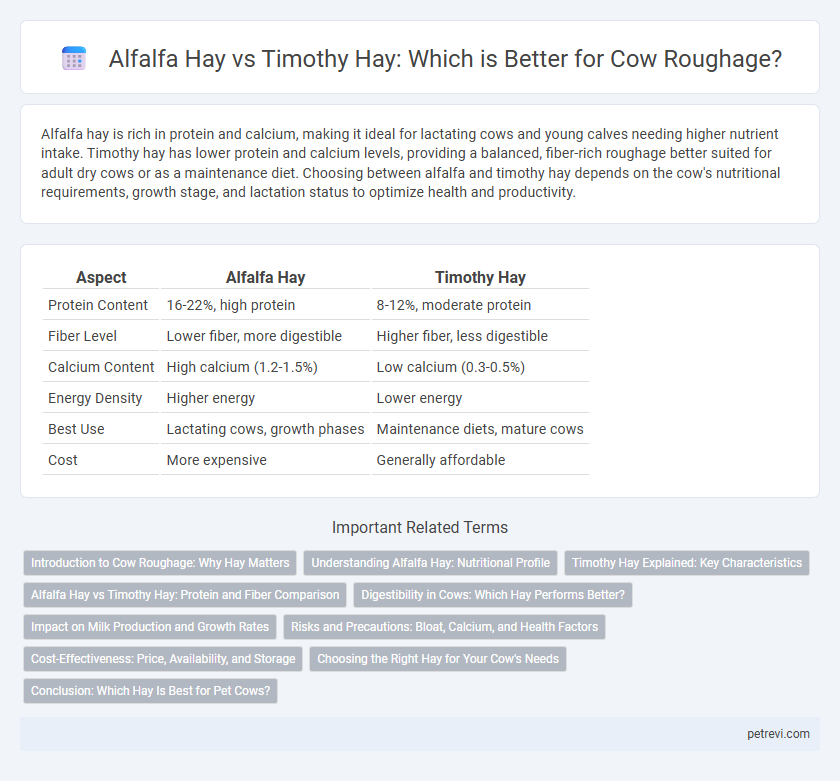Alfalfa hay is rich in protein and calcium, making it ideal for lactating cows and young calves needing higher nutrient intake. Timothy hay has lower protein and calcium levels, providing a balanced, fiber-rich roughage better suited for adult dry cows or as a maintenance diet. Choosing between alfalfa and timothy hay depends on the cow's nutritional requirements, growth stage, and lactation status to optimize health and productivity.
Table of Comparison
| Aspect | Alfalfa Hay | Timothy Hay |
|---|---|---|
| Protein Content | 16-22%, high protein | 8-12%, moderate protein |
| Fiber Level | Lower fiber, more digestible | Higher fiber, less digestible |
| Calcium Content | High calcium (1.2-1.5%) | Low calcium (0.3-0.5%) |
| Energy Density | Higher energy | Lower energy |
| Best Use | Lactating cows, growth phases | Maintenance diets, mature cows |
| Cost | More expensive | Generally affordable |
Introduction to Cow Roughage: Why Hay Matters
Alfalfa hay provides high protein and calcium essential for cows' growth and milk production, making it a valuable roughage source. Timothy hay, rich in fiber and lower in protein, supports healthy digestion and weight maintenance in adult cows. Choosing the appropriate hay type optimizes nutrient intake, promoting overall bovine health and productivity.
Understanding Alfalfa Hay: Nutritional Profile
Alfalfa hay offers a rich nutritional profile for cows, containing high levels of protein, calcium, and energy, essential for growth and milk production. Its digestible fiber supports rumen health and efficient digestion compared to Timothy hay, which is lower in protein but higher in fiber content. Choosing alfalfa hay enhances nutrient intake and supports lactating or growing cattle with increased dietary demands.
Timothy Hay Explained: Key Characteristics
Timothy hay is a high-fiber roughage preferred for cows due to its balanced nutrient profile and palatability, supporting optimal rumen health and digestion. It contains lower protein and calcium levels compared to alfalfa hay, reducing risks of metabolic disorders and making it ideal for adult cows with maintenance or moderate energy needs. The coarse stems and leafy texture of Timothy hay encourage chewing and saliva production, enhancing saliva's buffering effect on stomach acidity and promoting overall digestive efficiency.
Alfalfa Hay vs Timothy Hay: Protein and Fiber Comparison
Alfalfa hay contains higher protein levels, typically ranging from 17% to 20%, making it ideal for lactating cows requiring more energy and nutrients. Timothy hay offers lower protein content, usually between 8% and 12%, but provides superior fiber quality essential for rumen health and proper digestion. Balancing alfalfa hay with timothy hay optimizes both protein intake and fiber structure, promoting overall cow health and milk production efficiency.
Digestibility in Cows: Which Hay Performs Better?
Alfalfa hay generally offers higher digestibility compared to timothy hay, making it a preferred roughage for cows requiring nutrient-dense forage. Its elevated protein and energy levels support enhanced rumen fermentation and nutrient absorption, promoting better milk production and weight gain. Conversely, timothy hay, with its lower protein but higher fiber content, benefits cows needing slower digestion and reduced risk of acidosis.
Impact on Milk Production and Growth Rates
Alfalfa hay offers higher protein and energy levels compared to Timothy hay, significantly enhancing milk production and accelerating growth rates in dairy cows. The increased nutrient density in alfalfa supports rumen health and boosts lactation yield, making it a preferred roughage choice for maximizing dairy output. Timothy hay, while beneficial for fiber content and digestive function, typically results in slower growth and lower milk volumes.
Risks and Precautions: Bloat, Calcium, and Health Factors
Alfalfa hay, high in protein and calcium, poses a greater risk of bloat in cows compared to Timothy hay, which is lower in protein and safer for animals prone to digestive issues. Monitoring calcium intake is crucial, as excessive levels from alfalfa can lead to milk fever and urinary calculi, especially in lactating cows. Proper hay selection and gradual dietary changes help mitigate health risks, ensuring balanced roughage intake for optimal rumen function and overall cow health.
Cost-Effectiveness: Price, Availability, and Storage
Alfalfa hay typically offers higher protein content but comes at a higher price compared to timothy hay, making timothy hay more cost-effective for routine roughage in cows. Timothy hay is more widely available and easier to store due to its lower moisture content, reducing spoilage and storage costs. Farmers often choose timothy hay for bulk feeding to optimize budget while maintaining adequate nutritional value for cattle.
Choosing the Right Hay for Your Cow's Needs
Alfalfa hay provides higher protein and calcium content, ideal for lactating cows and growing calves needing extra nutrients. Timothy hay offers a lower protein and calcium profile, better suited for maintenance diets and adult cows with lower energy requirements. Selecting the right hay depends on your cow's age, production stage, and nutritional demands to ensure balanced roughage intake.
Conclusion: Which Hay Is Best for Pet Cows?
Timothy hay offers a balanced fiber-to-protein ratio ideal for maintaining healthy digestion in pet cows, making it a superior choice for roughage. Alfalfa hay, while richer in protein and calcium, can lead to excessive weight gain and digestive issues if fed in large quantities. For optimal health, Timothy hay is generally recommended as the best primary roughage for pet cows, with alfalfa used sparingly as a nutritional supplement.
Alfalfa Hay vs Timothy Hay for Cow Roughage Infographic

 petrevi.com
petrevi.com